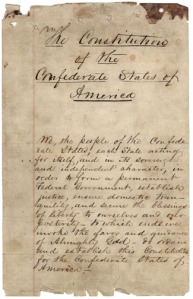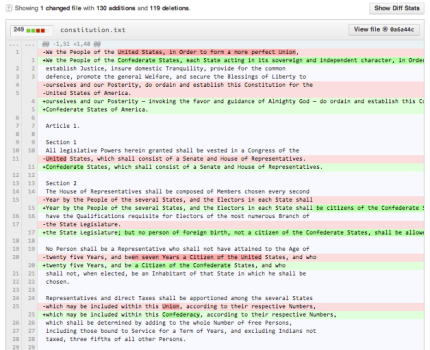Around this time last year, we discussed the idea of a constitutional “fork” that occurred with the founding of the Confederate States of America. That post briefly explains how forks work in open source software and how the Confederates used the US Constitution as the basis for their own, with deliberate and meaningful differences. Putting the two documents on Github allowed us to compare their differences visually and confirm our suspicions that many of them were related to issues of states’ rights and slavery.
Caleb McDaniel, a historian at Rice who undoubtedly has a much deeper and more thorough knowledge of the period, conducted a similar exercise and also posted his results on Github. He was faced with similar decisions of where to obtain the source text and which differences to retain as meaningful (for example, he left in section numbers where I did not). My method identifies 130 additions and 119 deletions when transitioning between the USA and CSA constitutions, whereas the stats for Caleb’s repo show 382 additions and 370 deletions.
What should we draw from these projects? In Caleb’s words:
My decisions make this project an interpretive act. You are welcome to inspect the changes more closely by looking at the commit histories for the individual Constitution files, which show the initial text as I got it from Avalon as well as the changes that I made.
You can take a look at both projects and conduct a difference-in-differences exploration of your own. More generally, these projects show the need for tools to visualize textual analyses, as well as the power of technology to enhance understanding of historical and political acts. Caleb’s readme file has great resources for learning more about this topic including the conversation that led him to this project, a New York Times interactive feature on the topic, and more.



